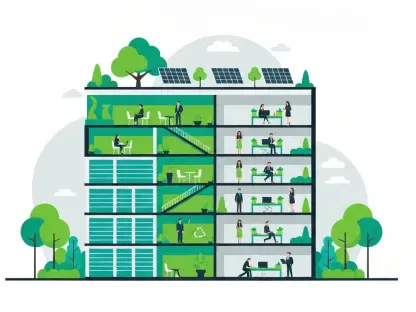Over the past few decades, universities worldwide have increasingly prioritized sustainability within their campus initiatives, driven by an urgent need to address environmental challenges. Among these institutions, Emory University stands out as a leader in sustainable campus living, exemplified by its latest milestone—the LEED Gold certification for its new graduate student housing development, The Ridge. This development underscores Emory’s dedication to sustainable building practices and its broader sustainability goals. By integrating energy-efficient features, resource-conserving technologies, and occupant health considerations, Emory not only supports the well-being of its community members but also demonstrates a long-standing commitment to environmental leadership.
The Ridge: A Model for Sustainable Design
Incorporating Innovative Resource-Conserving Technologies
The Ridge is more than just a graduate student housing facility; it is a hallmark of sustainable infrastructure at Emory University. In attaining its LEED Gold certification, The Ridge becomes a tangible expression of Emory’s strategic vision to blend resource-efficient practices with the health and welfare of its community. This residential project employs comprehensive stormwater management systems, consisting of holding tanks, swales, and rain gardens, which promote natural infiltration and minimize pollution through effective runoff control. In doing so, The Ridge not only preserves the local ecosystem but also enhances the sustainability of its immediate environment. Additionally, the incorporation of native plantings and the preservation of mature trees in the courtyard enrich the living space with natural beauty and ecological significance. These elements are central to Emory’s approach, ensuring that architecture harmonizes with nature while providing tangible environmental benefits.
Focusing on Energy Efficiency and Water Conservation
The Ridge advances Emory University’s sustainability efforts through a focus on energy efficiency and water conservation. Each residential unit is equipped with ENERGY STAR appliances, including efficient dishwashers, refrigerators, and laundry machines. This focus yields expected energy savings of 325,512 kilowatt-hours per year—an impressive 25.9% increase over standard buildings. Such a commitment to energy savings not only reduces utility costs but also diminishes the carbon footprint of the entire development. Parallel to energy efficiency, The Ridge demonstrates significant progress in water conservation, with an anticipated annual savings of 8,688,060 gallons. This represents a 36.36% increase in water savings compared to typical constructions. By integrating these measures, The Ridge secures its status as a model of sustainable student living, reflecting the university’s forward-thinking approach to environmental challenges.
The Broader Context of Emory’s Sustainability Milestones
A Legacy of Green Building Practices
The Ridge is a continuation of Emory’s long-established tradition of integrating sustainable design into its campus infrastructure. Emory’s journey in sustainable building design began with the LEED certification of the Whitehead Biomedical Research Building in 2002 and continued with the Goizueta Business School’s groundbreaking LEED Gold certification for Existing Buildings in 2005. This legacy signifies more than just isolated implementations; it represents a comprehensive effort to institute sustainable practices across multiple campus projects. The Ridge stands as Emory’s 42nd LEED-certified building, with 21 of these achieving the prestigious Gold status. Emory’s systematic expansion in green building certifications is a cornerstone of its strategic goal to enhance sustainability across its sprawling 16 million-square-foot campus.
Emory’s Strategic Sustainability Goals
The establishment of The Ridge and other pioneering projects aligns with Emory University’s overarching climate and sustainability objectives. Emory acknowledges the interconnectedness of its carbon emissions with energy consumption and has undertaken ambitious goals to mitigate its environmental impact. In the current year, Emory is committed to achieving a 50% reduction in greenhouse gas emissions, with the broader target of reaching net-zero emissions by 2050. Central to meeting these goals is the implementation of energy-efficient practices across campus facilities, as roughly 72% of emissions are attributed to building operations. Since the baseline year, Emory’s strategic efficiency upgrades have resulted in a significant decrease in emissions, illustrating the university’s proactive stance in using green design to tackle climate change.
Future Directions and Legacy of Sustainable Leadership
Expanding Green Initiatives
The Ridge not only embodies Emory University’s past achievements but also lays the groundwork for future sustainable developments. As Emory prepares for the next phase of Graduate Student Housing, it is anticipated that the forthcoming buildings will advance the sustainable principles set by The Ridge. These future projects are poised to integrate contemporary sustainability features that further critical climate action efforts, reinforcing Emory’s commitment to a greener future. As the institutional plan progresses, Emory’s dedication to sustainability continues to inspire other universities and fosters broader dialogue on environmental responsibility.
Implications for Sustainable Campus Efforts
In recent years, universities around the globe have increasingly focused on sustainability as a core part of their campus initiatives. This movement is largely motivated by the urgent need to tackle pressing environmental issues. Emory University has emerged as a pioneer in this area, highlighted by their recent achievement of receiving a LEED Gold certification for The Ridge, a new graduate student housing project. This accomplishment reflects Emory’s firm commitment to sustainable building practices and aligns with their extensive sustainability objectives. By incorporating energy-efficient systems, resource-saving technologies, and prioritizing the health and wellness of occupants, Emory not only enhances the living conditions of its community members but also showcases its enduring dedication to environmental stewardship. Emory University’s initiative serves as a model of how educational institutions can integrate sustainability into their core values, demonstrating leadership in creating a more sustainable and healthy future.









